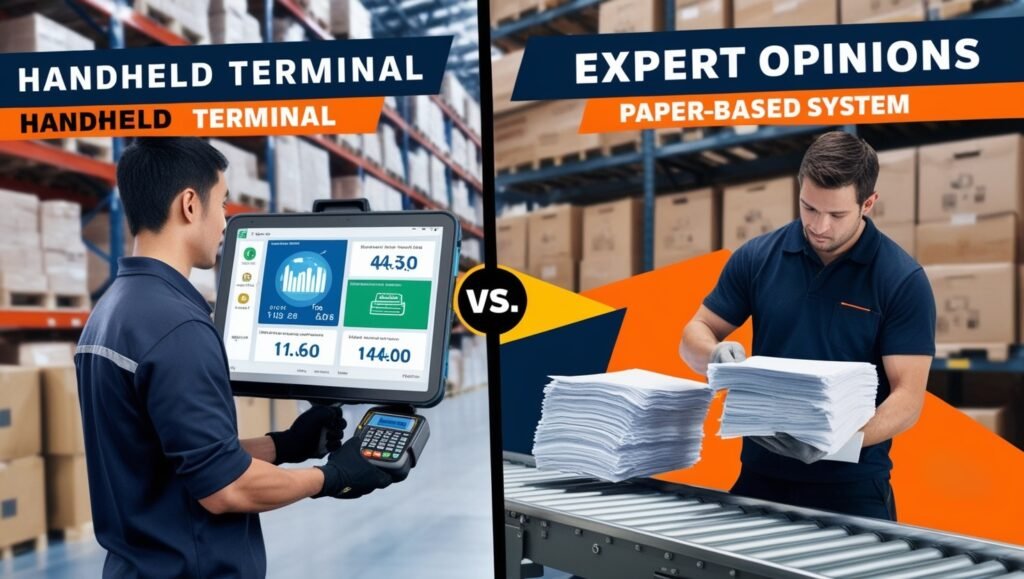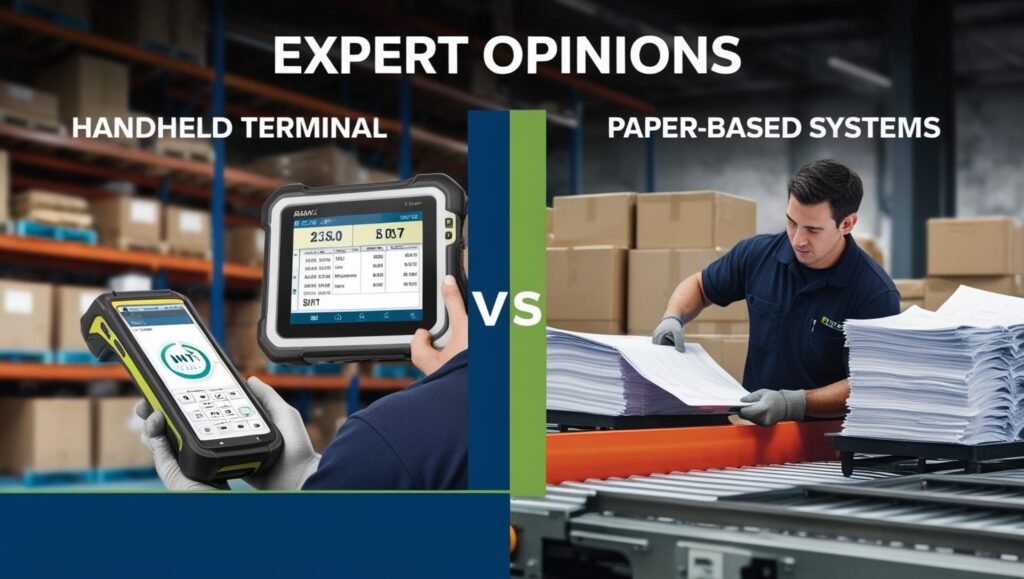- Introduction
- Traditional Paper-Based Systems
- Modern handheld terminals
- Case studies
- Conclusion
- Frequently Asked Questions
- What are the main differences between paper-based systems and handheld terminals in warehousing?
- Paper-based Systems (WMS)
- What are the benefits of using paper-based systems in warehousing?
- What are the disadvantages of paper-based systems?
- HHT-based Systems
- What benefits do handheld terminals offer in a warehouse setting?
- What are the potential drawbacks of handheld terminals?
- Paper-based systems and HHT-based systems
- In what scenarios might a paper-based system be more suitable than handheld terminals?
- How can a warehouse use a handheld terminal over a paper-based system?
- Is there a hybrid solution that combines paper-based systems and handheld terminals?
- How do handheld terminals improve inventory accuracy compared to paper-based systems?
- Future Trends
- What future trends are emerging in warehouse management systems?
Introduction
In the dynamic world of warehousing, efficiency and accuracy are supreme. As technology continues to advance, traditional methods such as paper-based systems are being challenged by modern handheld terminals. Both methods have their pros and cons, and understanding these can help warehouse managers make informed decisions.

Traditional Paper-Based Systems
Advantages of Paper-Based Systems
Simplicity: Paper systems are straightforward and require minimal training. Employees can easily record information, and the process is generally understandable to all.
Cost-Effective: Initial setup costs are low. There is no need for expensive equipment or software, making it an attractive option for smaller operations.
No dependency on power: Paper does not require electricity or batteries, ensuring that operations can continue even during power outages or technical failures.
Disadvantages of Paper-Based Systems
Potential for errors: Manual data entry increases the likelihood of errors. Ill-written or misplaced documents can cause significant problems.
Time-consuming: Recording information by hand and then transferring it to a central system is a time-consuming task and can delay operations.
Storage and retrieval: Managing large amounts of paper can be cumbersome. Finding specific documents can be a tedious process, slowing down operations.
Effect on the environment: The use of paper leads to deforestation and generates waste, making it less sustainable.

Modern handheld terminals
Advantages of HHT-Based Systems
Accuracy: Handheld terminals reduce human error to a great extent. Scanning barcodes or QR codes ensures that data is captured accurately.
Real-time updates: Data entered into a handheld terminal can be instantly synced with a central system, allowing for real-time inventory management.
Efficiency: Automating data entry makes processes faster. Employees can complete tasks faster, improving overall productivity.
Space savings: Digital records eliminate the need for physical storage, freeing up space in the warehouse.
Integration: Handheld terminals can integrate with other systems, such as warehouse management systems (WMS), providing a seamless flow of information.
Disadvantages of HHT-Based Systems
Initial investment: The cost of purchasing handheld devices and the necessary software can be high. The investment can be challenging for smaller warehouses.
Training requirements: Employees need to be trained to use the new technology, which can take time and resources.
Dependency on technology: Handheld terminals require a stable power source and reliable internet connectivity. Technical failures can disrupt operations.
Maintenance: Equipment requires regular maintenance and updates to ensure optimal performance, which increases ongoing costs.
Case studies
Success with handheld terminals
A large e-commerce company implemented handheld terminals in its warehouses. The result was a 30% increase in picking accuracy and a 20% reduction in order processing time. The ability to track inventory in real-time allowed for better demand forecasting and inventory management.
Challenges with Paper-based Systems (WMS)
A mid-sized manufacturing company relied on paper-based systems for inventory management. They often faced stock discrepancies and order fulfillment delays. Transitioning to handheld terminals helped them achieve greater accuracy and efficiency, which ultimately led to increased customer satisfaction.

Conclusion
Choosing between a paper-based system and a handheld terminal depends on a variety of factors, including warehouse size, budget, and specific operational needs. While paper systems may still be suitable for smaller operations with limited budgets, the benefits of handheld terminals make them an attractive option for those seeking greater accuracy, efficiency, and real-time data management.
Investing in modern technology can yield long-term benefits, putting warehouses in a better position to handle increasing demands and complexities in the supply chain. Ultimately, the shift toward handheld terminals represents a step toward a more streamlined, efficient, and sustainable future in the warehouse.
Frequently Asked Questions
What are the main differences between paper-based systems and handheld terminals in warehousing?
Paper-based systems:
Manual data entry: Information is recorded by hand on physical documents.
Low initial cost: Minimal investment is required for paper and pens.
No dependency on electricity: Operates without the need for electricity or batteries.
Prone to errors: High risk of human error in data entry and document handling.
Time consuming: Slow processes due to manual recording and transfer of information.
Handheld terminals:
Automated data entry: Data is captured electronically via barcode scanners or touchscreens.
High initial investment: Requires purchasing devices and software.
Real-time updates: Instant data synchronization with central systems.
Accurate: Minimizes human error with automated data capture.
Efficient: Speeds up processes, increases productivity and accuracy.
Paper-based Systems (WMS)
What are the benefits of using paper-based systems in warehousing?
Simplicity: Easy to implement and understand with minimal training.
Cost-effective: Low initial setup costs.
No technology dependency: Functions without electricity or internet, ensuring seamless operations.
Tangible records: Physical documents can be useful for audit and legal purposes.
What are the disadvantages of paper-based systems?
Error-prone: High risk of mistakes in manual data entry and interpretation.
Inefficiency: Time-consuming processes slow down operations.
Storage issues: Managing and retrieving large amounts of paper can be cumbersome.
Environmental impact: Contributes to deforestation and generates waste.
HHT-based Systems
What benefits do handheld terminals offer in a warehouse setting?
Accuracy: Reduces human error with automated data capture.
Efficiency: Speeds up tasks such as picking, packing, and inventory management.
Real-time data: Instant synchronization with central systems for up-to-date information.
Space-saving: Eliminates the need for physical document storage.
Integration: Seamlessly integrates with warehouse management systems (WMS) for streamlined operations.
What are the potential drawbacks of handheld terminals?
Initial investment: High upfront costs for the device and software.
Training requirements: Employees require training to effectively use new technology.
Technological dependency: Requires stable power and Internet connectivity.
Maintenance: Devices require regular updates and maintenance.
Paper-based systems and HHT-based systems
In what scenarios might a paper-based system be more suitable than handheld terminals?
Small warehouses: Paper-based systems may be more viable for limited budgets and simple operations.
Remote locations: Areas with unreliable power or Internet connectivity can rely on paper without interruption.
Low-tech environments: Warehouses whose employees are not tech-savvy may benefit from the simplicity of a paper-based system.
Temporary operations: Short-term projects or temporary warehouses may prefer the lower setup costs and quicker implementation of a paper-based system.
How can a warehouse use a handheld terminal over a paper-based system?
Assessment: Evaluate current processes and identify areas where handheld terminals could add value.
Budget planning: Allocate funds to purchase devices, software, and training.
Pilot program: Implement handheld terminals in a small portion of the warehouse to test effectiveness.
Training: Provide comprehensive training to employees on how to use the new device and software.
Gradual rollout: Gradually expand the use of handheld terminals throughout the warehouse.
Ongoing support: Provide ongoing support and maintenance to ensure smooth operations.
Is there a hybrid solution that combines paper-based systems and handheld terminals?
Yes, many warehouses use a hybrid approach, which integrates both paper-based systems and handheld terminals. This allows them to leverage the simplicity and cost-effectiveness of paper for some tasks while using the accuracy and efficiency of handheld terminals for others. For example, paper-based systems can be used for less critical functions, while handheld terminals handle real-time inventory management and order processing.
How do handheld terminals improve inventory accuracy compared to paper-based systems?
Handheld terminals improve inventory accuracy by:
Automated scanning: Barcodes and QR codes reduce manual entry errors.
Real-time data entry: Quick updates ensure accurate and current inventory levels.
Eliminating duplicate entries: Centralized systems prevent duplicate records and discrepancies.
Consistent data formats: Standardized data entry formats reduce misinterpretation.
Future Trends
What future trends are emerging in warehouse management systems?
IoT integration: Internet of Things (IoT) devices for real-time tracking and monitoring.
Artificial intelligence: AI-powered analytics for predictive inventory management.
Robotics: Automated guided vehicles (AGVs) and robotic arms for handling goods.
Cloud-based solutions: Centralized data access and management through cloud platforms.
Blockchain: Enhanced security and transparency in supply chain operations.
